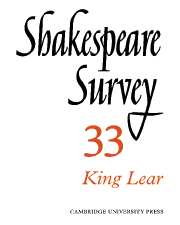Book contents
- Frontmatter
- King Lear: A Retrospect, 1939–79
- Some Conjectures on the Composition of King Lear
- The War in King Lear
- King Lear: Art Upside-Down
- ‘And that’s true too’: King Lear and the Tension of Uncertainty
- The Taming of the Shrew and King Lear: A Structural Comparison
- Medium and Message in As You Like It and King Lear
- Playing King Lear: Donald Sinden talks to J. W. R. Meadowcroft
- Hamlet’s Special Providence
- Antony and Cleopatra: ‘The Time of Universal Peace’
- Patterns of Motion in Antony and Cleopatra
- Theme and Structure in The Winter’s Tale
- Peter Street at the Fortune and the Globe
- English Actors at the Courts of Wolfenbüttel, Brussels and Graz during the Lifetime of Shakespeare
- Shakespeare at Stratford and the National Theatre, 1979
- The Year's Contributions to Shakespearian Study 1 Critical Studies
- 2 Shakespeare’s Life, Times, and Stage
- 3 Textual Studies
- Index
- Plate Section
2 - Shakespeare’s Life, Times, and Stage
Published online by Cambridge University Press: 28 March 2007
- Frontmatter
- King Lear: A Retrospect, 1939–79
- Some Conjectures on the Composition of King Lear
- The War in King Lear
- King Lear: Art Upside-Down
- ‘And that’s true too’: King Lear and the Tension of Uncertainty
- The Taming of the Shrew and King Lear: A Structural Comparison
- Medium and Message in As You Like It and King Lear
- Playing King Lear: Donald Sinden talks to J. W. R. Meadowcroft
- Hamlet’s Special Providence
- Antony and Cleopatra: ‘The Time of Universal Peace’
- Patterns of Motion in Antony and Cleopatra
- Theme and Structure in The Winter’s Tale
- Peter Street at the Fortune and the Globe
- English Actors at the Courts of Wolfenbüttel, Brussels and Graz during the Lifetime of Shakespeare
- Shakespeare at Stratford and the National Theatre, 1979
- The Year's Contributions to Shakespearian Study 1 Critical Studies
- 2 Shakespeare’s Life, Times, and Stage
- 3 Textual Studies
- Index
- Plate Section
Summary
In a recent interview on trends in Shakespeare studies (among many other things) Kenneth Muir, who ought to know, answered Gareth Lloyd Evans’s question ‘Is the file on Shakespeare’s sources closed now?’ with an emphatic negative. Professor Muir appears to have changed his mind since he wrote fifteen years ago in ‘The Future of Source-Hunting’ that with the completion of Geoffrey Bullough’s work there was little more to be discovered of plot sources, but that our knowledge of Shakespeare’s reading is still fragmentary. Little shards and slivers are hopefully breathed, shined and blown up in Notes and Queries and elsewhere, but John Erskine Hankins’s new book is a veritable museum of exhibits, systematically catalogued and, for the most part, elegantly presented. Professor Hankins, who in Shakespeare’s Derived Imagery provided a serviceable set of criteria for evaluating the validity of hypothetical sources, concentrates mainly on Shakespeare’s use of science and philosophy. The strategy is to survey general intellectual sources and then focus on Shakespearian examples. Sometimes the survey, while interesting in itself, does not illuminate Shakespeare very much and in general it is fair to say that the author is more concerned to note the occurrence of a particular idea or image in Shakespeare than to examine his use of it; that is, he has virtually no interest in context or criticism.
- Type
- Chapter
- Information
- Shakespeare Survey , pp. 194 - 204Publisher: Cambridge University PressPrint publication year: 1981



